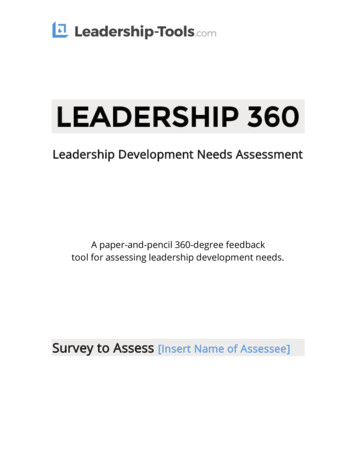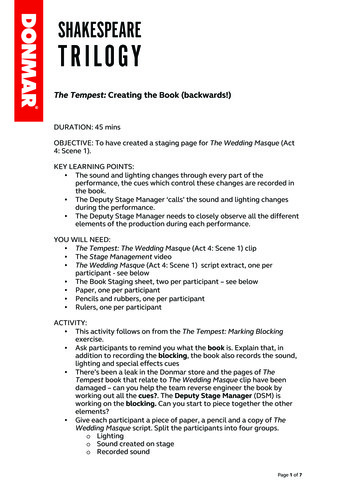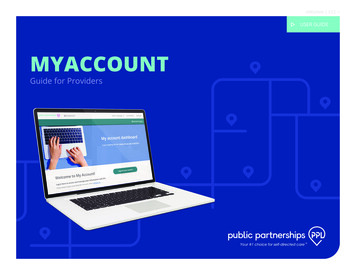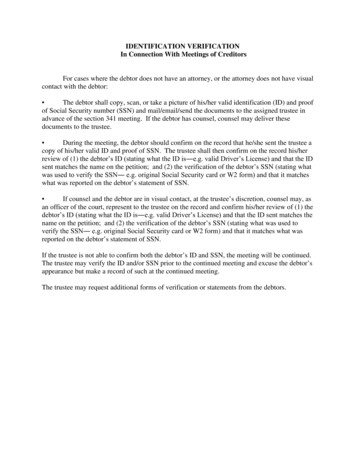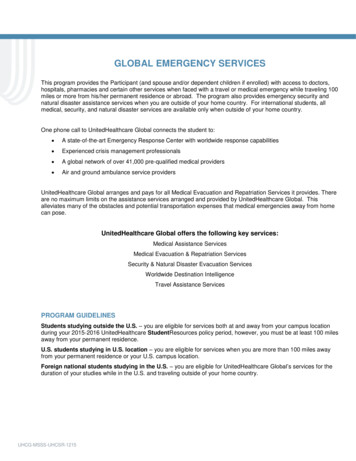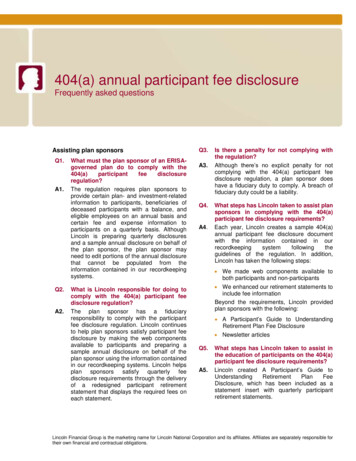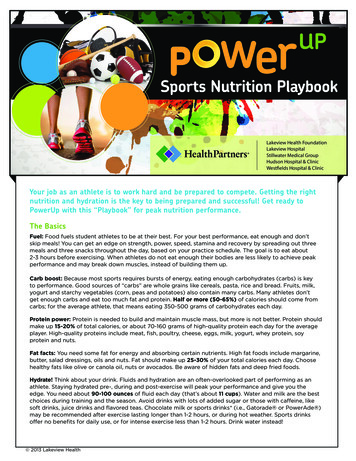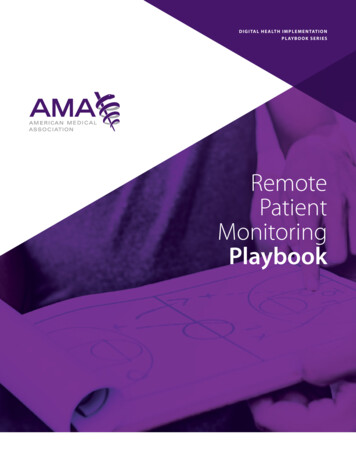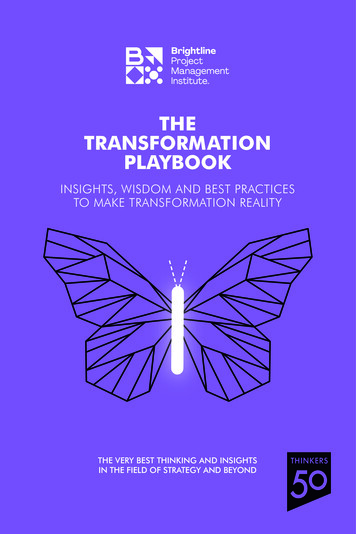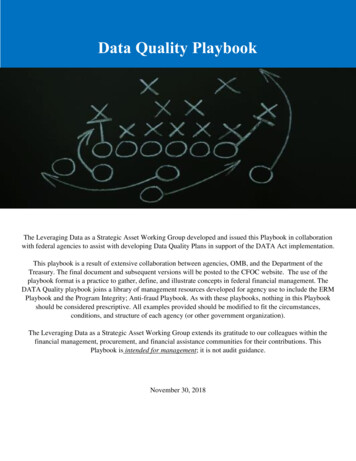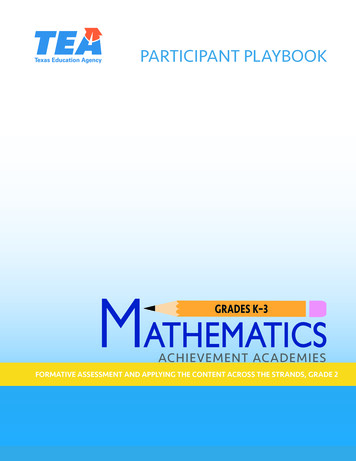
Transcription
PARTICIPANT PLAYBOOKFORMATIVE ASSESSMENT AND APPLYING THE CONTENT ACROSS THE STRANDS, GRADE 2
CopyrightCopyright Notice:The materials are copyrighted and trademarked as the property of the Texas Education Agency (TEA) andmay not be reproduced without the express written permission of TEA, except under the following conditions:1. Texas public school districts, charter schools, and Education Service Centers may reproduce and usecopies of the Materials and Related Materials for the districts’ and schools’ educational use withoutobtaining permission from TEA.2. Residents of the state of Texas may reproduce and use copies of the Materials and Related Materials forindividual personal use only without obtaining written permission of TEA.3. Any portion reproduced must be reproduced in its entirety and remain unedited, unaltered and unchangedin any way.4. No monetary charge can be made for the reproduced materials or any document containing them;however, a reasonable charge to cover only the cost of reproduction and distribution may be charged.Private entities or persons located in Texas that are not Texas public school districts, Texas Education ServiceCenters, or Texas charter schools or any entity, whether public or private, educational or non-educational,located outside the state of Texas MUST obtain written approval from TEA and will be required toenter into a license agreement that may involve the payment of a licensing fee or a royalty.For information, contact:Office of Copyrights, Trademarks, License Agreements, and RoyaltiesTexas Education Agency1701 N. Congress Ave.Austin, TX 78701-1494Phone: 512-463-9041Email: copyrights@tea.texas.govVersion 1.2Mathematics Achievement Academy: Formative Assessment and Applying the Content Across the Strands, Grade 21
AcknowledgmentsTEXAS EDUCATION AGENCY:Lily Laux, Deputy Commissioner, School ProgramsMonica Martinez, Associate Commissioner, Standards and Support ServicesShelly Ramos, Senior Director, Curriculum Standards and Student Support DivisionJo Ann Bilderback, Director of Mathematics, Curriculum Standards and Student Support DivisionJulie Kuhn, Mathematics Academy Coordinator, Curriculum Standards and Student Support DivisionEDUCATION SERVICE CENTER REGION 13 PROJECT STAFF:Millie Klein, Ed.D., Deputy Executive DirectorMarilyn Peebles, Associate Director: Statewide GrantsErin Romero, Associate Director: Special ProjectsSamantha Muñoz, Coordinator: Special ProjectsLaura Cherry, Project Specialist: Special ProjectsEDUCATION SERVICE CENTER REGION 4 CONTENT DEVELOPMENT TEAM:Kori Keaton, Education Specialist, Mathematics, Region 4 Education Service CenterStefani Kulhanek, Ed.D., Education Specialist, Mathematics, Region 4 Education Service CenterChristina Lincheck, Education Specialist, Mathematics, Region 4 Education Service CenterCrystal Munsinger, Education Specialist, Mathematics, Region 4 Education Service CenterShelley Bolen-Abbott, Senior Education Specialist, Mathematics, Region 4 Education Service CenterSharon Benson, Ed.D., Director, Mathematics, Region 4 Education Service CenterWE ALSO EXTEND SINCERE THANKS TO THE FOLLOWING INDIVIDUALS,WHO OFFERED THEIR INSIGHTS, PERSPECTIVES, AND ADVICE:Jane F. Schielack, Professor Emerita, Department of Mathematics, Texas A&M UniversityYvette Gomez, Component Director, School Support Services, Education Service Center Region 20Lindsey Perry, Research Assistant Professor, Research in Mathematics Education, Simmons School ofEducation and Human Development, Southern Methodist UniversityJane Tarr, Elementary Math Consultant, Region 7 Education Service CenterLynn McCollum, Elementary Math Consultant, Region 16 Education Service CenterKay Stickels, Math Consultant, Region 8 Education Service CenterJanna Higgins, Curriculum Consultant, Region 14 Education Service CenterMandy Smetana, Education Specialist, Region 15 Education Service CenterKristi Greaves, Education Specialist, Region 3 Education Service Center2 2022 Texas Education Agency. All Rights Reserved.
Table of ContentsFormative Assessment.5Student Motivation.7Learner Profile and Math Goal Page.9Learner Profile Interview Questions Exemplar.13Feedback.15Purposeful Teacher Questioning.17Learning Intentions and Success Criteria.19Learning Intentions and Success Criteria Example.21Self-Assessment and Peer Assessment.23Self-Assessment Tracker.25Content Goals and Language Goals.29Student Action Planning and Tracking Tool.31Student Goal Setting.39Effective Student Questioning.41Effect Size References.43Length Measurement.45Elements of Length Measurement Information Page.47Elements of Length Measurement Tasks.49Length Measurement Vertical Alignment Graphic Organizer.59Introducing Learning Intentions and Success Criteria Script.61Developing Understandings.65Completed Length Measurement Developing Understandings.67Mathematics Task Checklist.69Cognitive Demand Descriptors.71Three-Act Tasks.73Composing and Decomposing Figures.77Puzzle Promise Proof Protocol.79Developmental Phases of Composing and Decomposing Figures.81Developmental Phases of Composing and Decomposing Figures.83Composing and Decomposing Figures Learning Intentions and Success Criteria Exemplar .85Co-Constructing Success Criteria Script.87Co-Constructing Success Criteria Work Sample.91Composing and Decomposing Figures Developing Understandings Exemplar.93Julia’s Shapes.95Compare and Connect.97Data Analysis.99Data Analysis Learning Progressions and TEKS Information.101Data Analysis Learning Intentions and Success Criteria Exemplar.105Continued Conversations About Success Criteria Script.107Data Analysis Developing Understandings Exemplar.109Exemplar Anticipating Responses and Monitoring Questions Tool. 111Anticipating Responses and Monitoring Questions Tool. 119Co-Craft Questions.121References.123Mathematics Achievement Academy: Formative Assessment and Applying the Content Across the Strands, Grade 23
4 2022 Texas Education Agency. All Rights Reserved.
Formative AssessmentMathematics Achievement Academy: Formative Assessment and Applying the Content Across the Strands, Grade 25
6 2022 Texas Education Agency. All Rights Reserved.
Student MotivationSelf-EfficacyA learner’s belief in their ability to succeed ina particular situationSelf-AssessmentA learner’s act of observing and analyzingtheir own performance based on explicitcriteria and determining how they canimproveSelf-RegulationThe degree to which a learner is activelyparticipating in their own learningSelf-AttributionA learner's own perception or explanation forperformance that determines the amount offuture effort they will expend(Moss & Brookhart, 2019) 2021 TexasEducationAgency. Allrights reserved.MathematicsAchievementAcademy:Formative Assessment and Applying the Content Across the Strands, Grade 27
8 2022 Texas Education Agency. All Rights Reserved.
Mathematics Achievement Academy: Formative Assessment and Applying the Content Across the Strands, Grade 29It helps when my teacher lets me . . .I like . . . I like . . .I like . . . Picture My strength is . . .I am learning to . . .Mathematician:Learner Profile and Math Goal Page
10 2022 Texas Education Agency. All Rights Reserved.
Mathematics Achievement Academy: Formative Assessment and Applying the Content Across the Strands, Grade 211Attach picture.I will . . .For this learning intention, mycommunication goal is to beable to . . .For this learning intention, mygoal is to be able to . . .I will support my learning by . . .Language GoalMath GoalMathematician’s Goal SheetLearner Profile and Math Goal Page
12 2022 Texas Education Agency. All Rights Reserved.
Mathematics Achievement Academy: Formative Assessment and Applying the Content Across the Strands, Grade 213 2021 Texas Education Agency. All rights reserved.I see that you are a strongbecause you .Can you give me an example?As we are learning to beproficient mathematicians, howwill help you with?I see that your teacher helps youbecause . . .Can you give me an example?I see you like because.Why is that important to you?Date:Date:Learner Profile Interview Questions ExemplarInterview Questions:
14 2022 Texas Education Agency. All Rights Reserved.
FeedbackCharacteristics Provides clear and specific information that fills a gap between what is already understoodand the learning destinationClarifies the learning goalReinforces student success, corrects errors, clarifies misconceptions, or suggestsimprovements to move the student toward achieving the success criteriaDescribes changes the learner can make in order to arrive at the learning destinationstated in the learning intention and success criteriaMay address the quality of student’s work as well as the process observedMay come from multiple sources, such as teacher or peersHelps students become agents of their own learningTypes of Feedbacko Accuracy Feedback: Ideal for students who are beginning their exploration of aconcepto Connecting Concepts: Ideal for students who are developing their understanding ofa concept or connecting concepts to move masteryo Self-Regulation Feedback: Ideal for extending the thinking of students who areproficient or accomplished with the current success criteriaEffect SizesFeedbackeffect size: 0.732Student motivation2effect size: 0.56Assessment-capable learnerseffect size: 1.33Self-regulation of learning3effect size: 0.524Student Benefits Develops assessment-capable learnersDevelops self-regulated learnersSupports student motivationSupports student achievementProvides students with mathematical tools to move them closer to their learningdestinationSelf-Regulated LearnerA self-regulated learner asks: Where am I going? Where am I now? What tools will help me get to my learning destination?Mathematics Achievement Academy: Formative Assessment and Applying the Content Across the Strands, Grade 215
16 2022 Texas Education Agency. All Rights Reserved.
Purposeful Teacher QuestioningCharacteristics Teacher questions are planned and provide students the opportunity to articulate theirthinking.Teachers ask thought-provoking questions to promote critical thinking, modelmetacognitive thinking, and elicit a variety of student responses.Teachers use wait time to hold all students accountable for learning and increase thecomplexity of student responses.Questions focus students on the learning intentions and success criteria.Teachers model questions that experienced learners ask to seek clarity.Effect SizesSelf-regulation of learning3effect size: 0.52Concentration, persistence, and engagementeffect size: 0.563Student Benefits Develops students’ ability to self-regulate learningIncreases student concentration, persistence, and engagement in the learning destinationSupports student self-assessmentSupports students in making progress toward their learning goalsQuestioning Cycle with Wait TimeTeacher asks questionWait TimeWait TimeTeacher asks anotherquestion or calls onanother studentStudent respondsWait TimeMathematics Achievement Academy: Formative Assessment and Applying the Content Across the Strands, Grade 217
18 2022 Texas Education Agency. All Rights Reserved.
Learning Intentions and Success CriteriaCharacteristicsLearning Intentions: Provide clarity for students and teachers by identifying the learning destination Answer the question, “What is the intended goal?” Clearly state what students are learning and why they are learning it Are global statements that do not contain specific details, content, or a description of a task Maintain the rigor of the student expectation Are written in kid-friendly language that is meaningful to studentsSuccess Criteria: Provide clarity for students and teachers by providing a map for reaching the learning destination Answer the question, “What will it take to reach this goal?” Describe in detail how the evidence of learning will be demonstrated and how the learning intentionwas achieved Are written in precise language and avoid subjective language (i.e.: few, most, some)Effect SizesTeacher clarity1Student self-efficacyeffect size: 0.75effect size: 0.923Deep motivation and approach3Sharing learning intentions and success criteria with studentseffect size: 0.692Assessment-capable learners4effect size: 1.13effect size: 1.33Student Benefits Develops assessment-capable learners whoocan articulate what they are learning and why they are learning itoknow what they will do to show what they have learnedocan self-assess their own understanding and determine their next steps Increases confidence and self-efficacy Increases motivation and willingness to engageGuiding Questions for Developing Learning Intentions Does a big picture outcome appear as you read the student expectation(s)? Does the big picture outcome contain what all of the student expectation(s) in the chunk or unitare targeting for student learning? Would a set of more specific components provide clarity for how students can successfully reachthe big picture outcome?Guiding Questions for Developing Success Criteria What evidence would demonstrate that students have achieved conceptual understanding? What process might students need to follow to demonstrate their understanding? What product would provide evidence of student understanding? What academic vocabulary would students need to use to share their evidence of understanding?Almarode, J., & Vandas, K. L. (2018). Clarity for learning: Five essential practices that empowerstudents and teachers. Thousand Oaks, CA: eAssessment and Applying the Content Across the Strands, Grade 2 2021 TexasEducationAgency.All RightsReserved.19
20 2022 Texas Education Agency. All Rights Reserved.
Learning Intentions and Success Criteria Example2(4)(C) The student is expected to solve one-step and multi-step word problems involvingaddition and subtraction within 1,000 using a variety of strategies based on place value,including algorithms.Know and Show ChartKnowChanging the order of addends will resultin the same sum.Changing the grouping of three or moreaddends will result in the same sum.Numbers may be decomposed to addmore efficiently.Every addition fact has a relatedsubtraction fact.A variety of flexible strategies may beused for addition and subtraction. Show Add numbers within 1,000.Subtract numbers within 1,000.Determine whether a problem will requireone step or multiple steps.Determine which operation may be usedto solve a problem.Solve one-step addition problems within1,000.Solve one-step subtraction problemswithin 1,000.Solve multi-step problems involvingaddition and subtraction within 1,000.Learning IntentionWe are learning to solve word problems using addition and subtraction so that we can applythese problem-solving skills in our daily life.Success CriteriaI can . . . Determine which operation or operations may be used to solve a problem. Solve one-step addition problems within 1,000. Solve one-step subtraction problems within 1,000. Solve multi-step problems involving addition and subtraction within 1,000. Solve addition and subtraction problems using at least two different strategies.Mathematics Achievement Academy: Formative Assessment and Applying the Content Across the Strands, Grade 2 2021 Texas Education Agency. All Rights Reserved.21
22 2022 Texas Education Agency. All Rights Reserved.
Self-Assessment and Peer AssessmentCharacteristicsSelf-Assessment Students evaluate their own success compared to the success criteria. Students become aware of their strengths, progress, and learning gaps and determine their nextsteps in their own learning journey. The process occurs routinely during learning or instructional activities and before summativegrades. Teachers provide students feedback on their self-assessments.Peer Assessment Students compare a classmate’s work to the success criteria to provide feedback. A set of peer-assessment expectations or guidelines is recommended to support a focus onlearning. This process occurs only after students are successful with self-assessment. The feedback provided identifies peers’ strengths and opportunities for improvement withjustification aligned to the success criteria.Effect SizesStudent self-efficacy3effect size: 0.92Positive peer influence1effect size: 0.53Assessment capable learners4effect size: 1.33Self-regulation of learningeffect size: 0.523Peer tutoring and feedback3effect size: 0.53Student Benefits Increase of self-efficacy and self-regulation of learningEngagement in self-regulatory behaviorsDevelopment of habits attending to one’s own learning progressSelf-Assessment versus Peer AssessmentSimilarities Involves students in their own assessment Involves assessment based on successcriteria Informs next steps of students’ learningjourney Requires a classroom culture of learning asopposed to a culture of evaluationDifferences Serves different purposes in formativeassessment Has different effects on increasing studentachievementMathematics Achievement Academy: Formative Assessment and Applying the Content Across the Strands, Grade 2 2021 Texas Education Agency. All Rights Reserved.23
24 2022 Texas Education Agency. All Rights Reserved.
Self-Assessment Tracker:Student Name DateSuccess CriteriaCheck-InTimeSelf-AssessmentCircle OneI gave myself this rating because . . .Success CriteriaCheck-InTimeSelf-AssessmentCircle OneI gave myself this rating because . . .Success CriteriaCheck-InTimeSelf-AssessmentCircle OneI gave myself this rating because . . .Mathematics Achievement Academy: Formative Assessment and Applying the Content Across the Strands, Grade 2 2021 Texas Education Agency. All Rights Reserved.25
26 2022 Texas Education Agency. All Rights Reserved.
Self-Assessment Tracker:Student Name DateSuccess CriteriaProgressCircle oneAction StepsI get it.I am almost there.I don’t get it.I get it.I am almost there.I don’t get it.I get it.I am almost there.I don’t get it.I get it.I am almost there.I don’t get it.Mathematics Achievement Academy: Formative Assessment and Applying the Content Across the Strands, Grade 2 2021 Texas Education Agency. All Rights Reserved.27
28 2022 Texas Education Agency. All Rights Reserved.
Content Goals and Language GoalsContent GoalsLanguage Goals 2021 Texas Education Agency. All rights reserved.Mathematics Achievement Academy: Formative Assessment and Applying the Content Across the Strands, Grade 229
30 2022 Texas Education Agency. All Rights Reserved.
Mathematics Achievement Academy: Formative Assessment and Applying the Content Across the Strands, Grade 231MaterialsStudent goalsOther 2021 Texas Education Agency. All Rights Reserved.“ will be working on . . .”“The success criteria for this learning intention is . . .”Success criteria and student goals.I know it will be important to share with as we begin this unit of learning, becauseI am excited to begin work with because our mathematicians .Student focus PrepareStudent Action Planning and Tracking Tool
32 2022 Texas Education Agency. All Rights Reserved.
Mathematics Achievement Academy: Formative Assessment and Applying the Content Across the Strands, Grade 233What appropriate student action would allow students to demonstrate evidence of attaining their goal?What tool, strategy, or communication supports will students use to reach their goal?What success criteria does the tool, strategy, or communication support?What is the current level of proficiency students can demonstrate with the tool, strategy, or communication support they will use toimplement their student action?How can the student use the tool, strategy, or communication support they will use to implement their student action at theircurrent level of proficiency?How will students be introduced to any new tools, strategies, or communication supports to implement their student action?How will students communicate with their teacher or peers that they need help, are frustrated, or are confused about their studentaction?How will students be provided alternative tools, strategies, or communication supports to use if they are not proficient with thechosen tool(s)? 2021 Texas Education Agency. All Rights Reserved.“If this tool doesn’t work as planned, we will .”frustration.”“We will continue to use to communicate to our math buddies and teacher when we need help or are experiencing“I will need to support as they use this tool for their student action.” How “Currently, students have a level of proficiency with this tool.”the success criteria .”“The (tool, strategy, or communication support) that will help students would be because . This aligns with“I believe that will be an appropriate student action for because . . .”What Student Action Planning and Tracking Tool
34 2022 Texas Education Agency. All Rights Reserved.
Mathematics Achievement Academy: Formative Assessment and Applying the Content Across the Strands, Grade 235When will students be made aware of their student actions?When will tools, strategies, or communication supports be introduced if new, or reinforced if existing, for students’ actions?When will students receive feedback, engage in self-reflection, and give feedback to teachers regarding their student actions andtool, strategy, or communication support?“We will update our student trackers .”feedback on their student action.”“After completing/while completing assignment/activity, I will give students an opportunity to reflect/provide/receive“I will introduce/inform students about on .”“I have scheduled time to share student actions.” WhenStudent Action Planning and Tracking Tool
36 2022 Texas Education Agency. All Rights Reserved.
Mathematics Achievement Academy: Formative Assessment and Applying the Content Across the Strands, Grade 237Language GoalFor this learning intention mygoal is to . . .Student Action:Student Action:Student Action:Student Action:Student Action:Math GoalFor this learning intention mygoal is to . . .Student Action:Student Action:Student Action:Student Action:Student Action: 2021 Texas Education Agency. All Rights Reserved.Mathematician I canSuccess Criteria:Learning Intention:Math Tools, Strategies,Language SupportsStudent Action Planning and Tracking ToolEvidence
38 2022 Texas Education Agency. All Rights Reserved.
Student Goal SettingCharacteristics Students and teachers collaborate to set goals that allow students to focus on their learningdestination.Goals are specific, detailed, measurable, and directly related to the current learning intention.Students set just-right goals, which are goals that are neither too challenging nor too easilyaccomplished.The process is cyclical, based on feedback of learning intention and success criteria change.Effect SizesAppropriate challenging goals2effect size: 0.68Metacognitive strategieseffect size: 0.602Learning goals versus no learning goals3effect size: 0.68Student Benefits Helps students focus on their learning destination by being active participants in their learning atthe appropriate levelSupports students in becoming self-regulated learnersDevelops resilience and increases persistence in learningImproves metacognition, or the act of thinking about one’s own thinkingMotivates students to learn new content strategies, communication strategies, and learningstrategiesSelf-Regulated LearnerA self-regulated learner asks Where am I going? Where am I now? What tools will help me get to my learning destination?Goal-Setting Process1. The student and teacher work together to review the learning intention and success criteria and seta clearly defined goal.2. Progress toward the student goal is monitored with feedback. Teacher provides ample time throughout the learning for students to demonstrate their newlearning. Student self-assesses and self-regulates to monitor and adjust what they are doing to attaintheir goal using the success criteria.3. Actions for improvement are taken based on the interpretation of feedback. Actions may include: Redefining the goal based on feedback.The student applying a different content strategy.Mathematics Achievement Academy: Formative Assessment and Applying the Content Across the Strands, Grade 2 2021 Texas Education Agency. All Rights Reserved.39
40 2022 Texas Education Agency. All Rights Reserved.
Effective Student QuestioningCharacteristics Provides all students the opportunity to exercise their mathematical voice throughout the learningprocessQuestions are asked by all learners and of all learners.Teachers’ role is to support students in:o Developing and using questioning skillso Learning to listen respectfullyo Developing critical listening skillsEffective questioners have:o Knowledge of the characteristics of effective questionso A desire to ask and answer questionso Motivation to connect ideas and/or develop deeper understandings of the mathematicsAsking a question may be to obtain:o Assistance when one is confusedooAdditional information when one is curiousA deeper understanding of what one is trying to achieve and masterEffect SizesStudent self-efficacyeffect size: 0.92
Yvette Gomez, Component Director, School Support Services, Education Service Center Region 20 Lindsey Perry, Research Assistant Professor, Research in Mathematics Education, Simmons School of Education and Human Development, Southern Methodist University Jane Tarr, Elementary Math Consultant, Region 7 Education Service Center
